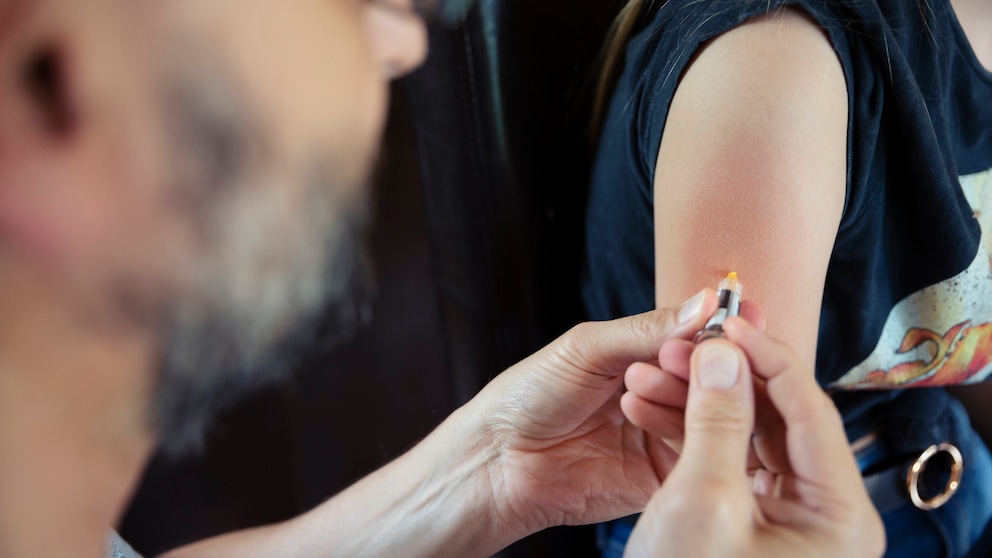April 22, 2025, 9:37 am | Read time: 4 minutes
More than 99 percent of cervical cancer cases are linked to an HPV infection, with one-third of these cases resulting in death. Vaccinating children against HPV can prevent this, including cancers and other diseases that also affect boys. FITBOOK explains why the HPV vaccination is so important for children.
Human papillomaviruses (HPV) are widespread, with most sexually active women and men becoming infected with these viruses at some point in their lives. In most cases, the infection is asymptomatic, but some virus types can cause cancer. An HPV vaccination during childhood or early adolescence significantly reduces the risk and is recommended for both girls and boys.
Overview
Diseases Caused by HP Viruses
To date, more than 200 different HPV genotypes have been identified. Some of them can cause benign genital warts in areas such as the cervix, vagina, vulva, anus, and throat. While these rapidly growing growths are not considered cancerous, they are unpleasant and can burn or itch. A healthy immune system often causes the warts to disappear on their own, or they can be treated with ointments, laser treatments, or freezing. After a few months to a maximum of two years, the infection is no longer detectable and thus healed. Other subtypes can cause precancerous conditions or cancer, including cervical cancer, anal cancer, oral cancer, nasal cancer, and throat cancer. In these cases, symptoms often do not appear for a long time or manifest as slight bleeding.1
Transmission of HP Viruses
Human papillomaviruses are transmitted through direct human-to-human contact. The viruses enter through micro-injuries in the skin or mucous membranes, most often through sexual intercourse, but also through petting. Depending on the sexual practice, they can enter the vaginal, anal, and even throat areas. Condoms do not provide sufficient protection. In very rare cases, transmission from mother to newborn during birth is possible.2
High-Risk HPV Types Can Cause Cancer
Statistically, young men and women are most often infected with the HP virus, usually without noticing. Studies have shown: The more sexual partners a man or woman has, the higher the likelihood of an HPV infection, according to the German Cancer Research Center. High-risk HPV types are those that can cause cancer. Data from Germany show that 23 out of 100 women aged 26 carry these types. Similar numbers are assumed for men of the same age. From the age of 35, the proportion decreases again, as fortunately, an intact immune system can eliminate the cancer-causing viruses in most cases.3 Nevertheless, in Germany, about 6,250 women and 2,900 men develop cancer caused by an HPV infection each year. Approximately 1,500 to 1,600 women die from it annually. According to the RKI, these are preventable deaths.
HPV Vaccination for Children – The Right Time
HPV vaccinations protect nearly 100 percent against infection with the HPV types contained in the vaccine. The STIKO (Standing Committee on Vaccination) therefore recommends vaccinating girls and boys before or at the onset of puberty, starting at age 9, but no later than age 17. The earlier the vaccination, the greater the protective effect against high-risk HPV types, as younger girls, according to the RKI, develop higher antibody levels than older ones. Ideally, especially with a delayed vaccination, no sexual intercourse should have occurred, as complete protection can no longer be achieved after the first infection.4 However, STIKO also recommends catching up on the vaccination at the latest. The costs are fully covered by health insurance.
Why HPV Vaccination is Important for Boys
The vaccination recommendation initially applied only to girls in 2007, and since 2018, also to boys. The reason: The more children and adolescents are vaccinated, the lower the risk of infection for themselves and others. Men are considered the main transmitters of the infection. A model calculation has shown that vaccinating boys can prevent thousands of cancer cases annually, especially in women. Additionally, the vaccination protects boys from unpleasant genital warts. And even though they cannot develop cervical cancer, HP viruses are responsible for penile and anal carcinomas as well as oral and throat cancer. In short: Vaccinating boys protects the entire population.5

A Mother’s Diabetes Can Increase the Risk of Autism in Her Child by 25 Percent

HPV Vaccination for Children: What Parents Should Know

Oncologist on Early Cancer Detection in Men: “Prostate Palpation Is ot Really Suitable”
Successes of HPV Vaccinations in Children
With the introduction of HPV vaccination for children and adolescents, the WHO (World Health Organization) quickly observed initial successes. Countries reported a measurable decline in HPV infection rates among adolescents and young adults. It usually takes several years to decades for cervical cancer to develop from an infection, so it may take time for the effects of the vaccination to become visible. Nevertheless, there are positive signs: Studies from Finland and the United Kingdom (Scotland) found no cases of cervical cancer among young women who were vaccinated against HPV at ages 12 to 13.6 The WHO aims for a vaccination rate of 90 percent. According to the RKI, Germany’s HPV vaccination rates for a complete series are only 54.6 percent for 15-year-old girls and 34 percent for boys.7

